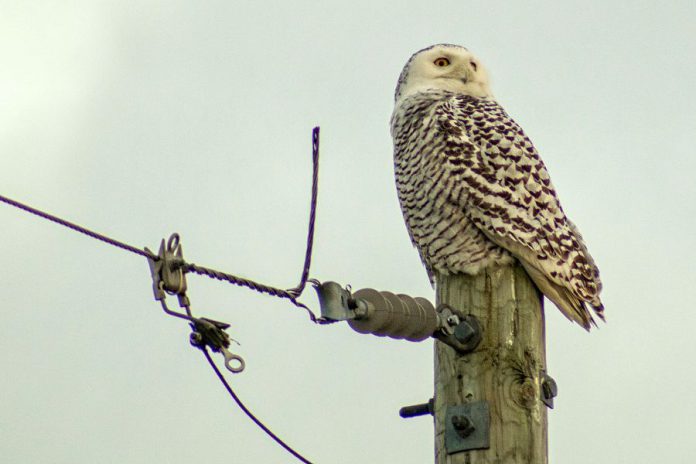
Owls are majestic birds, loved by many. Their deep-set, globular eyes, fluffy appearance, and broad wings make them a favourite among many birders. They’re also important members of the food chain, keeping rodents and other pests under control.
There’s been an owl invasion of sorts in Ontario this winter, as hundreds of snowy owls, arguably one of the most beautiful owl species, have flocked to our part of the country over the course of the past few weeks.
Social media has been flooded with photos of the birds perched atop telephone poles and wires, on the look out for the next meal. It seems the birds aren’t shy around humans, often allowing for close encounters of their surveillance operations.
The males are generally pure white, perfect camouflage in their native arctic home, with females and younger birds having black coloration across their backs and wings. Feathered feet, and striking yellow eyes make these photogenic birds a real treat to witness in the wild.
Why has Ontario seen so many of the birds?
Experts with the Cornell Lab of Ornithology in Ithaca, New York tell the PBS News Hour that it likely has to do with a bounty of prey in the owl’s breeding areas. With lemmings (the snowies’ prey of choice) plentiful, more owlets survived and flourished. With a sharp upswing in population, many of these young birds were forced to vacate their frigid northern homes, expanding their hunting areas further south.
Called an irruption, the movement of snowies was also witnessed last winter, and according to Scott Weidensaul, a naturalist and author with Cornell, some owls first spotted last winter have made a return back to their new-found southern hunting grounds.
“Snowy Owl Invasion” by Cornell Lab of Ornithology
“We’re seeing a lot of young birds, and the high nesting success in the Canadian Arctic likely contributed,” Wedidensaul told PBS. “But there are definitely more adult birds, many of them second-year owls based on their molt patterns, which may be birds that were part of the 2013-14 irruption.”
Cornell is taking advantage of the irruption of snowy owls, outfitting some birds with tracking devices to follow their movements as part of a program called Project Snowstorm (www.projectsnowstorm.org).
A snowy, nicknamed Millcreek, was tagged January 20 of last year near Erie, Pennsylvania. The owl’s movements were tracked showing it travelled from Buffalo, New York to the Ottawa area, then north to the sub-arctic regions of northern Quebec. It then returned south this fall, with signals being picked up in the Cornwall area of eastern Ontario. Due to the tracking device requiring a cell phone network connection to transmit data, the owl could disappear for months at time while in remote areas, with the stored location data being sent to researchers when it re-entered cell network coverage.
Wedidensaul said the data gathered from these birds also helps scientists learn about their behaviour.
“Some of what we’ve found confirms longstanding suspicions, such as the reliance on water bird prey like ducks, geese, gulls and grebes for coastal snowies,” he explained. “We’ve seen that some owls are profound homebodies, rarely straying more than a half-mile all winter from their tagging site, while others roamed across hundreds of miles. One of the biggest surprises was the way immature owls along the Great Lakes moved out onto the frozen lake surfaces for weeks or months at a stretch, apparently hunting cracks and leads in the ice plates where ducks and other waterfowl could be found.”
As the snowies’ arctic home is flat and barren, the birds are sticking to similar landscapes in southern Ontario. Flat, open fields allow the birds to easily hunt for prey. Airports have turned out to be a popular hangout for the birds, which, unfortunately, is quite dangerous.
Phil Roberts, manager of Windsor International Airport, told the CBC that the birds can be a real hazard to aircraft.
“Snowies are heavy birds and they also have no experience with humans or machinery, including aircraft. So the fact is they don’t react fast enough to stay out of the way of aircraft and, because they’re so big, the probability of an aircraft being damaged from hitting a snowy is very high.”
Staff at the airport have reportedly banded 30 of the birds in December alone. The snowies are caught and banded, then released far from the danger of planes and airport operations.
If you want to see a snowy, your chances are good. There have been many sightings in and around the Kawarthas. Check in open areas like fields where the birds will be likely found hunting for mice and other rodents.


























